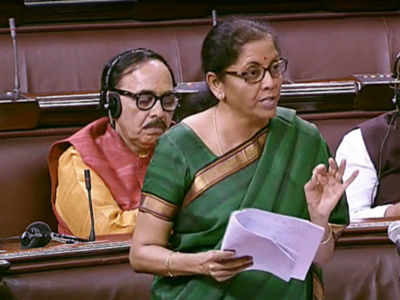If this is not recession, Nirmala Sitharaman, what is? ..?
 NEW DELHI : India’s Gross Domestic Product (GDP) growth slipped further to hit an over six-year low of 4.5 per cent in July-September. As soon as the GDP numbers were released, the Opposition attacked the Central government over the recent GDP data. Congress was one of the first ones to target the government over the slipping economic growth of the country.
NEW DELHI : India’s Gross Domestic Product (GDP) growth slipped further to hit an over six-year low of 4.5 per cent in July-September. As soon as the GDP numbers were released, the Opposition attacked the Central government over the recent GDP data. Congress was one of the first ones to target the government over the slipping economic growth of the country.
The GDP data for the latest quarter comes at a time when stress in the country’s financial sector, slowing demand, multi-year low auto sales and weak industrial production have hampered economic growth. India lost its position as the world’s fastest growing major economy last year. The government has set a target of making the country a $5-trillion economy by 2024.
Chief Economic Advisor Krishnamurthy Subramanian emphasized the fundamentals of the economy remain strong and said GDP growth is expected to pick up in the December quarter.
Taking a dig at the Prime Minister Narendra Modi-led government, Congress spokesperson Randeep Singh Surjewala said, “India’s GDP has collapsed to an abysmal 4.5%. We are in a virtual free-fall. This is the lowest GDP quarter in 6 years. But why is the BJP celebrating? Because their understanding of GDP ( Godse Divisive Politics) suggests double-digit growth levels. All in the perspective!”
India’s annual growth in gross domestic product or GDP fell to 4.5% for the quarter ended September 30, down from 5% in the previous three months and 7% for the corresponding period of 2018. Economists polled by Reuters had forecast GDP growth of 4.7% for the second quarter.
PM Narendra Modi’s government has taken several steps, including a big cut in corporate tax rate in September, to boost investments and bolster economic growth. Economists also see Reserve Bank of India cutting its repo rate for the sixth time in a row, by 25 basis points, to 4.90% at its December 3-5 meeting.
According to the data released by National Statistical Office (NSO), the gross value added (GVA) growth in the manufacturing sector contracted by 1% in the second quarter of this fiscal from 6.9% expansion a year ago. Similarly, farm sector GVA growth remained subdued at 2.1%, down from 4.9% in the corresponding period of the previous fiscal.
Construction sector GVA growth too slowed to 3.3% from 8.5% earlier. Mining sector growth was recorded at 0.1% as against 2.2% contraction a year ago. Electricity, gas, water supply and other utility services growth also slowed to 3.6% from 8.7% a year ago. Similarly, trade, hotel, transport, communication and services related to broadcasting growth was also down to 4.8% in the second quarter from 6.9% a year ago.
Financial, real estate and professional services growth slowed to 5.8% in the Q2 FY2019-20 from 7% a year ago. On the other hand, public administration, defence and other services reported improvement with an 11.6% rise during the quarter under review from 8.6% a year earlier.
On a half-yearly basis (April-September 2019), GDP growth came in at 4.8% as compared to 7.5% in the same period a year ago. “GDP at constant (2011-12) prices in Q2 of 2019-20 is estimated at ₹35.99 lakh crore, as against ₹34.43 lakh crore in Q2 of 2018-19, showing a growth rate of 4.5 percent,” an NSO statement said.
Gross Fixed Capital Formation (GFCF), which is barometer of investment, at constant (2011-2012) prices, estimated at ₹10.83 lakh crore in Q2 of 2019-20 as against ₹11.16 lakh crore in Q2 of 2018-19.
In terms of GDP, the rates of GFCF at Current and Constant (2011-2012) prices during Q2 of 2019-20 are estimated at 27.3% and 30.1%, respectively, as against the corresponding rates of 29.2% and 32.4%, respectively in Q2 of 2018-19.
“Growth rates of GFCF at Current and Constant Prices are estimated at (-) 0.9 percent and (-) 3.0 percent during Q2 of 2019-20 as compared to 16.2 percent and 11.8 percent during Q2 of 2018-19,” it added.
Finance Minister Nirmala Sitharaman on Wednesday, in parliamentary debate, said the economy faced a slowdown but no “recession” and cited several government measures to support economic growth. On Thursday, she sought parliament’s approval to spend an additional ₹21,000 crore this fiscal.
Some economists, however, said see economic growth picking up in the second half of the current fiscal year, after the government took steps to support real estate and non-bank finance companies. Indian stock markets have been on a record-breaking rally this month in expectations of an economic recovery over the next few quarter.
Separately, India’s infrastructure output contracted for the second consecutive month to 5.8% in October from a year earlier, lowest since at least April 2012, data released on Friday showed. During April-October, output grew 0.2% from the year-ago period, according to the data.
India’s fiscal deficit in the first seven months through October stood at ₹7.2 lakh crore, or 102.4% of the budgeted target for the current fiscal year, government data showed today. Net tax receipts in the April-October period was ₹6.83 lakh crore, while total expenditure was ₹16.55 lakh crore. (With Agency Inputs)

